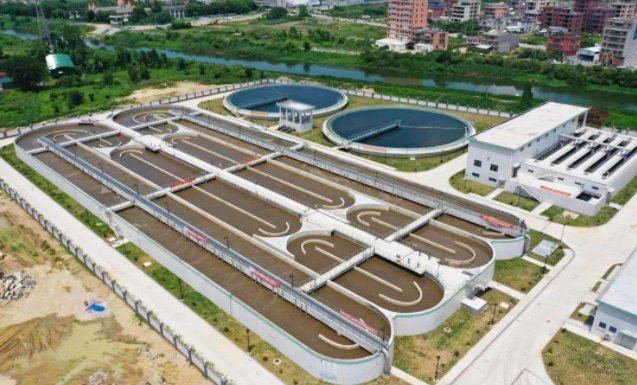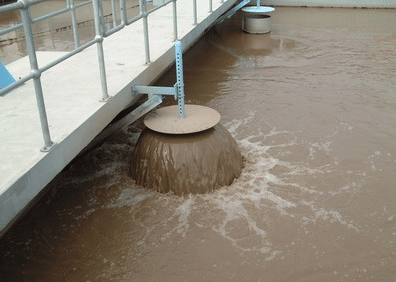Environmental activities and water purification are becoming more and more important. Most industries use water in one way or another in their processes. The used water needs to be treated before it is discharged in order to avoid adverse effects on the environment, either into the natural environment or into the sewage network, and the chemical and physical characteristics of the wastewater need to comply with the regulations in force.
There are several different types of wastewater treatment plants in operation, each of which treats wastewater in a different way. Water treatment plants have become imperative because they can help commercial and industrial facilities become environmentally friendly and compliant with regard to wastewater treatment.

The following will describe the five types of water treatment plants, how they work, and the industry applications for each type.
Wastewater treatment plant (WWTP)
Wastewater is water that originates from domestic, agricultural, commercial and industrial activities where it is used.
Basically, wastewater can be divided into two categories.
- Domestic wastewater—This is wastewater from domestic activities such as toilets, showers, etc.
- Industrial wastewater—This comes from commercial, industrial manufacturing activities and has a completely different composition than sewage.
How does it work?
- The first step in this water treatment plant is that the wastewater is discharged into the plant by gravity through the main sewer system.
- Then the pretreatment process begins, in which water flows through a gravel chamber (such as a grit classifier) to remove the gravel. The water then moves to a bar screen that removes large objects, these are coarse sunsets. Next smaller objects are removed through fine screens.
- Similar to the gravel tank, the grit sink allows any grit in the wastewater to settle on the bottle. It is then removed from the tank and disposed of at the landfill.
- Next comes the settling stage, also known as primary treatment. During this stage, water flows to the primary settling tanks, also known as pre-settlement tanks. These tanks have hoppers that are located at the bottom of the tank through which the water flows. This hopper moves around the rim, causing the treated water to remain at the rim while the most heavily settled particulate matter in the wastewater is deposited at the bottom of the tank.
- After the primary treatment is completed, the secondary treatment begins. This is also known as the biological stage because it uses natural processes and bacteria to consume contaminants in the water, such as any biodegradable organic compounds, carbon and phosphorus. These dead bacteria and organic residues are then turned into sludge.
- During this stage, excess sludge is pumped out and moved to settling tanks. These settling tanks allow the sludge to settle and then move to the digesters.
- In the digesters, the sludge is heated and mixed. Another important thing that happens here is the production of biogas, which the wastewater treatment plant can reuse to produce electricity or heat.
- When the sludge reaches its optimum level in the digester, the next digestion takes place in the storage tank. This allows water to be separated from the semi-solid sludge, while the remaining sludge is again dewatered in a mechanical process, i.e. as much water as possible is removed from the sludge.
- The sludge left after the digestion and dewatering process is completed is finally disposed of at the landfill.
- The final step in wastewater treatment is inspection. This inspection consists of checking the contamination level of the treated water and ensuring that it meets the highest standards for discharge or reuse for domestic or industrial purposes.
Applications
Most petrochemical and chemical industries generate large volumes of wastewater and require on-site wastewater treatment plants. Other industries such as paper and pulp production also generate large amounts of wastewater.
Sewage treatment plants (STP)
These treatment plants remove sewage waste from homes, commercial buildings, and sometimes even into commercial wastewater. It can also receive storm water and debris from sewers.
STPs clean wastewater through a series of chemical, physical and biological processes before it is discharged into the environment.
How does it work?
When wastewater arrives at a wastewater treatment plant, it goes through a filtration process that acts as a pretreatment process. Here the wastewater flows through a filter and enters a settling tank, which removes a large amount of debris.
As mentioned above, it occurs as pretreatment in three stages – primary, secondary and tertiary treatment – before.
Primary treatment
In this stage, the wastewater enters a clarifier. The effluent flows slowly through the settling tanks. It is the design of these tanks that causes settling, where organic solids collect at the bottom of the tank and lighter material floats to the top becoming easier to remove.
The organic material that settles at the bottom is called the primary sludge layer. After a few hours, the sludge that settles in the clarifier enters the aeration tank for another process called the activated sludge process.
Secondary Treatment
This treatment stage includes aerobic aeration. As the air flows through the aerators, small holes appear, turning them into bubbles and mixing them with the water column. This interaction of oxygen with the bacteria in the wastewater causes the bacteria to digest the organic matter, giving the wastewater its characteristic appearance and odor.
At the end of aeration, the wastewater flows into the next tank, the secondary clarifier. It is in this case that the bacteria settle at the bottom for a day or two and form a sludge layer, which can then be pumped out by the water treatment plant.
Once the sludge bed has settled completely, it becomes return activated sludge (RAS). This RAS is returned to the primary clarifier, where bacteria help break down any organic matter in the effluent.
Once the RAS has passed through the primary and secondary clarifiers in complete succession, it becomes waste activated sludge (WAS). The WAS then does not return to the primary clarifiers, but moves to covered tanks, also called aerobic sludge digesters. In these tanks, the bacteria do not digest the organic matter present in the wastewater, but the activated sludge begins to digest each other, causing most of the sludge to disappear.
Finally, the remaining sludge moves to a dewatering facility containing dewatering tanks, where the plant uses a filter press (usually a belt filter press or plate and frame filter press) to squeeze any remaining water out of the sludge.
Tertiary Treatment
Tertiary treatment follows the primary and secondary processes, but also involves mechanical and photochemical processes. This is a more advanced treatment method and is useful for domestic wastewater containing microbial contaminants that require disinfection.
In this treatment stage, the wastewater is passed through a sand filter to remove very fine particulate matter. The photochemical process takes place after this and the water flows under ultraviolet (UV) light, which will eliminate any bacteria and viruses, and remove any infection. Nowadays, sodium hypochlorite generators and ozone generator systems are also used for disinfection.
Thus, wastewater from a wastewater treatment plant is completely safe to discharge into the environment after the three stages mentioned above.
Applications
A good example of an STP is the treatment plants you find in large cities. Residential dwellings, commercial buildings, municipal wastewater, etc.
Effluent treatment plant (ETP)
As mentioned earlier, sewage treatment plants provide preliminary treatment for domestic or municipal purposes. Sewage treatment plants, on the other hand, are the exact opposite, as they treat industrial wastewater, i.e., wastewater that results from the flow of industrial by-products.
How does an ETP work?
Like STPs, ETPs involve processes of preliminary, primary, secondary and tertiary treatment.
Preliminary treatment: e.g. screening, sedimentation, filtration, clarification, etc. The aim is to remove as much solid physical matter as possible before sending the wastewater for further treatment.
Primary treatment: This stage involves the removal of solid waste and organic matter. Chemicals are added here to break down any solid and chemical wastes. This is accomplished by chemical coagulation, chemical precipitation or the addition of sodium carbonate or hydrochloric acid to control pH (done with polymer dosing systems).
Secondary treatment: Here suspended particles and any biodegradable materials are removed with the help of many chemical and biological processes.
Tertiary treatment: Tertiary treatment combines all three physical, chemical and biological processes.
Applications
ETP is used in a wide range of industries with high levels of chemical contamination in the wastewater, such as pharmaceutical manufacturing and chemical industries such as textile and dye manufacturing.
Demineralization (DM) treatment plants
In water treatment for industrial purposes, demineralization usually involves the complete removal of dissolved solids or minerals from the feed water or process stream.
How does it work?
The water treatment plant works on the principle of ion exchange. In these plants, special ion exchange resins are manufactured that help replace any minerals in the water.
The combination of anion and cation exchange removes virtually all ionic contaminants present in the feed water, a process called deionization.
Applications
Demineralization results in the complete removal of minerals from water and is commonly used in industries requiring high purity water, such as make-up or feed water in high-pressure boilers, the food and beverage industry, and in the manufacture of process flow electronics for industrial use.
Reverse osmosis (RO) water treatment
The principle of Reverse Osmosis (RO) acts as a filtration method to remove large amounts of contaminants and impurities from wastewater by applying pressure to the wastewater when it is located on one side of the membrane.
How does it work?
The water treatment plant works with a high-pressure pump that increases the pressure on the salt side of the RO, forcing the water through the semi-permeable RO membrane. In other words, when the wastewater enters the reverse osmosis membrane and pressure is applied, the water molecules pass through the semi-permeable membrane while other salts are not allowed to pass and are discharged to the waste stream.
Applications
Reverse osmosis water treatment plants are widely used in industries such as machinery, boiler feed water, food and beverage, and metal processing.
Wastewater treatment plant common system
The wastewater treatment capacity of different types of wastewater treatment plants varies, and four systems commonly used in various types of water treatment plants are listed below.
Activated sludge plant (ASP)
Activated sludge treatment plant, also known as activated wastewater treatment, is one of the most commonly used biological treatment methods. In this method, treatment conditions are provided by mixing the wastewater and a large number of active microorganisms in a tank and providing the necessary oxygen.

Carousel system
Wastewater treatment systems with carousel systems are a powerful and reliable solution for providing high quality wastewater. These systems are suitable for all applications and can be converted to existing wastewater management systems.
Submerged air filtration systems
Submerged drainage basin filtration systems are one of the common methods of wastewater treatment. The system also requires less maintenance due to the use of fewer moving parts.
With no need for regular operators and high effluent quality, submerged aeration systems are suitable for domestic and industrial wastewater treatment.
Sequential batch reactor (SBR)
Purification systems with continuous intermittent reactors are known as systems that use a specific sequence for purification. These systems have a high degree of flexibility and can treat a wide range of wastewaters.
Partner with KUOSI for both peace of mind and responsibility and environmental awareness when it comes to your water treatment plant and wastewater treatment. We offer water treatment solutions and equipment to help you spend less time worrying about waste management.
